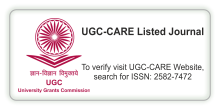SILK INDUSTRY IN CHHATTISGARH-SELF-RELIANT WOMEN
छत्तीसगढ़ में रेशम उद्योग-आत्मनिर्भर महिलाएँ
DOI:
https://doi.org/10.29121/shodhkosh.v5.i1.2024.5609Keywords:
Self-Reliance, Family-Related Specialization, Women's Organization, Employment GenerationAbstract [English]
Cocoon industry plays an important role in promoting women employment in rural areas of Chhattisgarh. Economic development of women is considered important for the prosperity of the society. Cocoon is a forest based industry. Women play a role in all the works from the production of cocoons in the landscape to the forest area to the production of silk. The participation of women in every work of this institutional industry has emerged as a very wide and special workforce, along with the activism of women, the standard of living of their families has increased and the revenue of the government has increased. One of the main reasons for the economic badminton of Chhattisgarh is the lack of prominence in its factors, problems of cultivation of raw materials and mainly the lack of contribution of women statistics etc.
The aim of the research is to analyse the problems of these industries and study the role of the government in eliminating them. From screening of women in handloom industry (silk industry) to development of understanding of circular discipline in the family and compilation of optimum vision of skill integration in the support group, the main elements of the research are.
Abstract [Hindi]
छत्तीसगढ़ के ग्रामीण क्षेत्रों में महिला रोजगार हेतु कोसा उद्योग की महत्वपूर्ण भूमिका रही है। महिलाओं के आर्थिक विकास को समाज की समृद्धि के लिए महत्वपूर्ण सूचक माना जाता है। कोसा वन आधारित उद्योग है। भौगोलिक दृष्टि से वनांचल क्षेत्रों में कोकुन की उपज से लेकर रेशम निर्माण के सभी कार्यों में महिलाओं की सशक्त भूमिका है। इस कुटीर उद्योग के प्रत्येक कार्य में महिलाओं की हिस्सेदारी अत्यन्त प्रभावशाली एवं विशिष्ट कार्यबल के रूप में उभरी है, महिलाओं की सक्रियता के फलस्वरूप इनके परिवार का जीवन स्तर ऊँचा हुआ है एवं शासन के राजस्व में बढ़ोतरी हुई है। छत्तीसगढ़ के आर्थिक पिछड़ेपन के प्रमुख कारणों में से एक कारण धीमा औद्योगिक विकास है, इसके कारको में आधारभूत संरचनाओं की कमी, कच्चे माल की उपलब्धता की समस्यायें एवं मुख्यतः महिला श्रमिकों के योगदान का अभाव आदि है। इन समस्याओं के निराकरण की सम्भावनाओं का विश्लेषण कर उन्हें दूर करने में सरकार की भूमिका का अध्ययन करना शोध का लक्ष्य है। हाथकरघा उद्योग (रेशम उद्योग) में महिलाओं की सहभागिता से परिवारों में वृत्तीय अनुशासन की समझ का विकास एवं सहायता समूह में संगठनात्मक कलेवर की अनुकूलतम दृष्टि का सर्वाधिक कथन शोध का प्रमुख तत्व है।
References
Singh, Ranjana: “A Sociological Analysis of the Problems of Workers in the Handloom Industry,” 2016.
Singh, Nandkishore: “The Handloom Industry in Eastern Uttar Pradesh,” 1988.
Tiwari, Manish: “An Analysis of the Socio-Economic Conditions of Weavers in Handloom and Cottage Industries Based on the Banukars of Varanasi Consciousness,” 2022.
Aggarwal, Shravan Kumar: “A Critical Study of the Economic Condition of Weavers in the Handloom Industry with Special Reference to the Jhansi Division in Uttar Pradesh.”
Chhattisgarh State Handloom Development and Marketing Cooperative Federation Limited, Raipur.
Member MD, Silk Industries, District-Janjgir-Champa (Chhattisgarh)
Administrative Report 2015-16
Rajya Divya 2021 Form.
Tripathi, Vishwadeep 2022 Form.
Chhattisgarh Story 2018 Form.
R.K. Meen/Archana - Article
RRS/CL - Article
Dr. Veeranna Gowda - Magazine
Baijal Kiran Kashyap - Paper
Deputy Director, Department of Silk
Textile Directorate
Central Silk Board (Ministry of Textiles, Government of India)
India Today
Ramesh Kumar Dewangan
Downloads
Published
How to Cite
Issue
Section
License
Copyright (c) 2024 S.K. Srivastava, Priyanka Udasi

This work is licensed under a Creative Commons Attribution 4.0 International License.
With the licence CC-BY, authors retain the copyright, allowing anyone to download, reuse, re-print, modify, distribute, and/or copy their contribution. The work must be properly attributed to its author.
It is not necessary to ask for further permission from the author or journal board.
This journal provides immediate open access to its content on the principle that making research freely available to the public supports a greater global exchange of knowledge.































